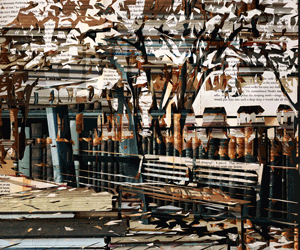t to the r to the a to the ash
How to Take Out the Trash
Co-authored by wikiHow Staff
Last Updated: February 24, 2021 References
Taking out the trash is something that most of us have to do on a regular basis. Not taking out the trash can create an unsanitary home or office environment. Although this is not a difficult task, there are tips that you can use to make it even easier.
Method
1
Taking Out the Trash
Image titled Take out the Trash Step 11
Secure the bag. Use the extra room at the top of the bag to securely tie a single knot so that the garbage does not fall out of the bag. Sometimes trash bags come with twist ties. Using these ties makes it easy to secure the contents of the bag. Gather the entire opening of the bag, close and place the twist tie around it.
The Great Pacific garbage patch (also Pacific trash vortex) is a garbage patch, a gyre of marine debris particles, in the central North Pacific Ocean. It is located roughly from 135°W to 155°W and 35°N to 42°N.[1] The collection of plastic and floating trash originates from the Pacific Rim, including countries in Asia, North America, and South America.[2] The gyre is divided into two areas, the "Eastern Garbage Patch" between Hawaii and California,
Find the Recycle Bin
Windows 10
If your desktop shows no icons at all, right-click (or press and hold) the desktop and select View. If Show desktop icons has no checkmark, click it to add one.
If that doesn't work, try this:
and the "Western Garbage Patch" extending eastward from Japan to the Hawaiian Islands.Despite the common public perception of the patch existing as giant islands of floating garbage, its low density (4 particles per cubic meter) prevents detection by satellite imagery, or even by
ccumulating.[5] The patch is believed to have increased "10-fold each decade" since 1945.[6] Estimated to be double the size of Texas, the area contains more than 3 million tons of plastic.[7] The gyre contains approximately six pounds of plastic for every pound of plankton.[8] A similar patch of floating plastic debris is found in the Atlantic Ocean, called the North Atlantic garbage patch.[9][10] This growing patch contributes to other environmental damage to marine ecosystems and species.
Image titled Take out the Trash Step 22
Double bag the trash if needed. Check to see if there are any holes in the bag. If so, double bag it by placing the entire bag inside of an empty bag.[1]
Image titled Take out the Trash Step 33
Take your bags to the designated pick-up location. Be sure nothing has been left behind or dropped during the transportation process.
To transport heavy items or more than one bag, either take more than one trip, ask for help, or use a dolly or wagon.
Image titled Take out the Trash Step 44
Move the bin to the street. If you live in a house and not an apartment, there are specific waste management guidelines to follow. Be sure to follow the rules for bin placement and pick up. You should set the trash out on time so that it does not pile up.
You can find your neighborhood’s trash pick up schedule with a quick online search. Most residents receive this information by mail from their local waste management service. It is generally provided when the trash pick up service is first scheduled.
If you place your trash in a community dumpster, replace the lid after dropping your trash bag into it. This will prevent rodents and animals from entering the dumpster.
Method
2
Maintaining a Trash Schedule
Image titled Take out the Trash Step 51
The patch was described in a 1988 paper published by the National Oceanic and Atmospheric Administration (NOAA). The description was based on research by several Alaska-based researchers in 1988 who measured neustonic plastic in the North Pacific Ocean.[11] Researchers found relatively high concentrations of marine debris accumulating in regions governed by ocean currents. Extrapolating from findings in the Sea of Japan, the researchers hypothesized that similar conditions would occur in other parts of the Pacific where prevailing currents were favorable to the creation of relatively stable waters. They specifically indicated the North Pacific Gyre.[12]
Charles J. Moore, returning home through the North Pacific Gyre after competing in the Transpacific Yacht Race in 1997, claimed to have come upon an enormous stretch of floating debris. Moore alerted the oceanographer Curtis Ebbesmeyer, who subsequently dubbed the region the "Eastern Garbage Patch" (EGP).[13] The area is frequently featured in media reports as an exceptional example of marine pollution.[14]
The JUNK Raft Project was a 2008 trans-Pacific sailing voyage made to highlight the plastic in the patch, organized by the Algalita Marine Research Foundation.[15][16][17]
In 2009, two project vessels from Project Kaisei/Ocean Voyages Institute; the New Horizon and the Kaisei, embarked on a voyage to research the patch and determine the feasibility of commercial scale collection and recycling.[18] The Scripps Institute of Oceanography's 2009 SEAPLEX expedition in part funded by Ocean Voyages Institute/Project Kaisei[19] also researched the patch. Researchers were also looking at the impact of plastic on mesopelagic fish, such as lanternfish.[20][21]
In 2010, Ocean Voyages Institute conducted a 30-day expedition in the gyre which continued the science from the 2009 expeditions and tested prototype cleanup devices.[22]
in July/August 2012 Ocean Voyages Institute conducted a voyage from San Francisco to the Eastern limits of the North Pacific Gyre north, (ultimately ending in Richmond British Columbia) and then made a return voyage which also visited the Gyre. The focus on this expedition was surveying the extent of tsunami debris from the Japanese earthquake-tsunami.[23][24]
Conduct a weekly sweep. Choose a set day of the week to pick up trash. This can include trash in containers at home and junk you may have in your car.
Image titled Take out the Trash Step 62
Set an alarm. Schedule a reminder on your smartphone, or another device, to take out the trash. Set your schedule based on trash pickup times.
Image titled Take out the Trash Step 73
Keep trash bags on hand. You can find trash bags at the grocery store and most retail establishments.
Trash cans are standard in size, especially those used in the kitchen. Many trash cans are measured in gallons.
There are odor absorbing and scented trash bags available in stores.
Select Start > Settings > Personalization > Themes > Desktop icon settings.
casual boaters or divers in the area. This is because the patch is a widely dispersed area consisting primarily of suspended "fingernail-sized or smaller bits of plastic", often microscopic, particles in the upper water column known as microplastics.[3] Researchers from The Ocean Cleanup project claimed that the patch covers 1.6 million square kilometers.[4] Some of the plastic in the patch is over 50 years old, and includes items (and fragments of items) such as "plastic lighters, toothbrushes, water bottles, pens, baby bottles, cell phones, plastic bags, and nurdles." The small fibers of wood pulp found throughout the patch are "believed to originate from the thousands of tons of toilet paper flushed into the oceans daily."[3]
Research indicates that the patch is rapidly a
Make sure the check box for Recycle Bin is checked, then select OK. You should see the icon displayed on your desktop.
Note: If you are in tablet mode, desktop icons are not displayed. To see your desktop icons in tablet mode, go to Start > Settings > System > Tablet Mode. Hide app icons on the taskbar in tablet mode and Automatically hide the taskbar in tablet mode should be turned off.
Some municipalities may require clear bags.
Image titled Take out the Trash Step 84
Periodically clean the trash can. Cleaning the trash can every few months can help to reduce odor and insects. Use warm soapy water for general cleaning. You can also use a mild disinfectant to sterilize the trash can to reduce odor. [2]






















Prikaži Komentarje
Komentarji
Čudovito
Komentiraj